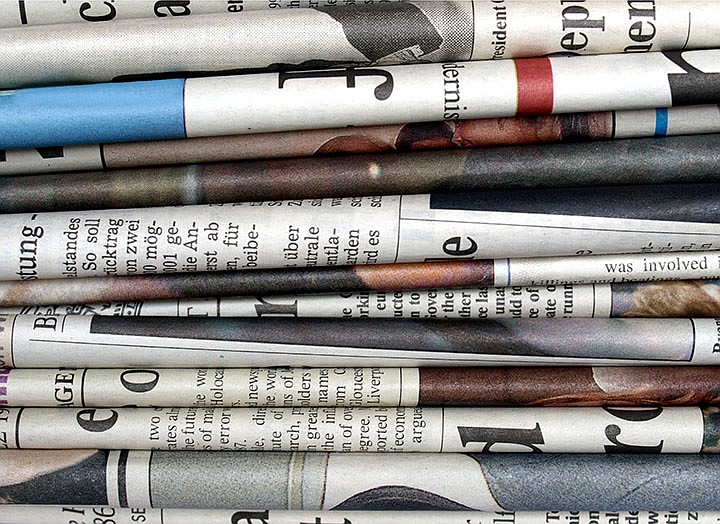The rumors of our death - as a newspaper business - have once again been greatly exaggerated.
Mark Twain said it first, long before Politico magazine's senior media writer Jack Shafer decided to try building a coffin for print newspapers in his Sunday piece titled "Sell the New York Times. Now. And other unsolicited advice for A.G. Sulzberger."
The piece opens with Chattanooga.
"The cult worship of The New York Times commenced not long after that day in 1896 when Adolph S. Ochs of Chattanooga, Tennessee, spent a mess of borrowed money to purchase controlling ownership in the respected but failing Republican-tilting paper and appoint himself publisher."
The occasion for Shafer's writing, dripping with sarcasm, was the Times' announcement of another generation - about five or six now - ascending to take the "throne" of "King Ochs." Ochs' 37-year-old great-great-grandson, A.G. Sulzberger, became publisher of the paper Jan. 1.
Shafer's comments go downhill from there, some sounding downright green-eyed with jealousy.
"Naturally, the transfer of power made Page One news in the Times. ... Why do we invest so much in the Times and its publisher? The appointments of other newspaper publishers don't rate this sort of treatment."
Yes, they do. Even small papers write front page or section front stories about new publishers, presidents - even editorial writers. Newspapers do this for transparency so their readers know who the editors and managers are.
But Politico continues: "Even President Donald Trump acknowledged the royal transition, sending a 'Congratulations!' tweet to the Times' new ruler before slapping his 'failing' paper around a little."
Politico again: "The hard thing about giving A.G. advice in 2018 is that most of the problems facing him faced Arthur Jr. when he became king. ... In a 1993 piece, the New Yorker's Ken Auletta asked, 'Will [the Times] continue to print on paper, or will it distribute news only electronically? Will it be a national or an international paper? What will its advertising base be? Will technology be an ally or an enemy?'"
These are questions facing not only newspapers and magazines, but also cable news stations and cable company owners as they grapple with streaming media. Why, among other things, do we think net neutrality is an underplayed big deal?
Politico: "Here we are 25 years later, and the only question Auletta posed that has been resolved is the fate of its advertising base, which is on its way to extinction. The Times is still no closer to making the print-electronic decision, nor should it. 'Print is profitable every day of the week without a single ad dollar,' A.G. recently boasted to the New Yorker's David Remnick. Just before the paper built its paywall, it commissioned a study to determine how many digital subscribers it could attract. Fewer than 1 million, the experts predicted. They were wrong. The paper now has about 2.5 million digital-only subscribers while maintaining a print subscriber base of about 1 million, a surge some attribute to the Trump victory."
Sweet! Trump is good for something. But not even our so-called president's penchant for outrageous words and actions are the sole buoy for the bottom line of what Trump falsely - as usual - calls the "failing" New York Times and other newspapers - all caught in the shifting world of advertising and technology in manufacturing and communication. Still, Shafer takes another sip of the Trump Twitter-news Kool-Aid:
"Times Company revenues, $1.56 billion in 2016, are nowhere near their pre-recession peak, and all of the unsolicited advice in the world won't bring them back. ... A.G. needs to worry about those digital subscribers evaporating when Trump moves out of the White House. Either that or find a way to engineer his 2020 reelection. ..."
Does anyone really think all news fits in 140 characters and revolves around Trump? That would negate nuclear war, false reports of nuclear war, climate change, tornadoes, hurricanes, even local news.
"Short of encouraging A.G. to invent the next Facebook, or load up on the digital currency of the week, what sort of advice can we honestly advance?" Politico asks rhetorically.
Try this, Mr. Shafer: Facebook's Mark Zuckerburg just lost $3.3 billion thanks to his decision Friday that content from family and friends, and not media outlets and businesses, will dominate Facebook's news feed in the future. Zuckerburg's decision follows Facebook's defacto hostile takeover by Russia bots,' fake news and fake ads. We're just saying.
It seems money is the real fly in the ointment of the Politico piece. Shafer, like many a reporter who occasionally can't see the news because he's lost in the weeds of his beat, seems to care more about the Ochs' family fortunes than its news legacy.
Adolph Ochs' final testament when he died in 1935 called for the Times to be maintained "as an independent newspaper, entirely fearless, free of ulterior influence, and unselfishly devoted to the public welfare." Read those last two words again. Public welfare.
Henry Ford didn't just build cars. He built a newly mobile America. Similarly, Ochs and family don't just publish newspapers. They inform, educate and shape a knowledgeable America. How many Facebook pages - replete with ads from Russian bots - do that? How many Twitter feeds?
Politico gave the new Times publisher some lines in the story, though the magazine still missed the point:
"Advertising, A.G. tells Remnick, once accounted for 80 percent of the paper's revenues. Today, subscribers contribute two-thirds of revenues. Formerly, the paper had to satisfy two constituencies, readers and advertisers. But now that subscribers and not advertisers provide the most revenue for the Times, the paper's primary customers are readers."
Ah-ha! That brings us to NEWS - the real seller. For the real customers - readers. We rest our case.
